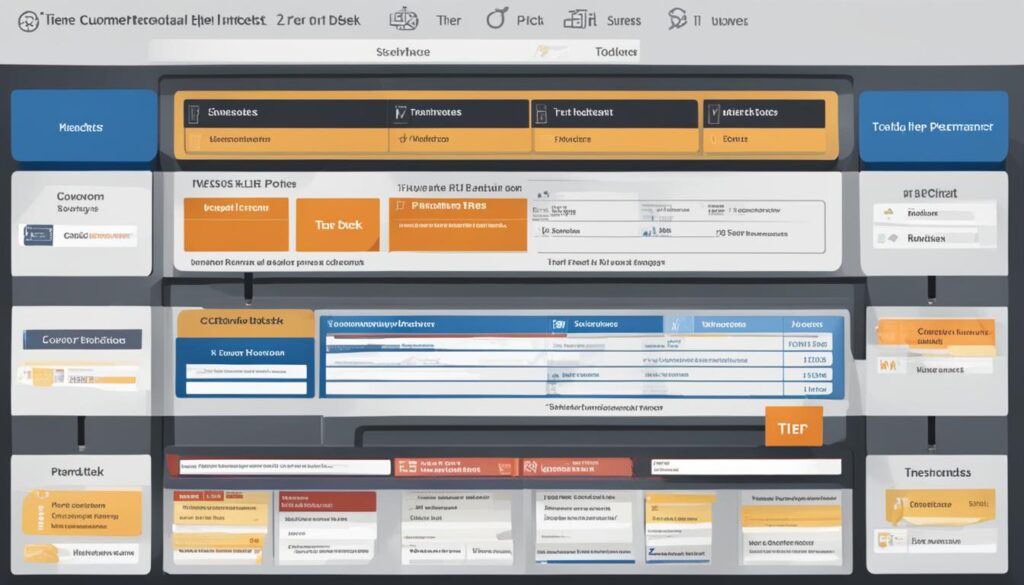Implementing best practices for a help desk can greatly enhance efficiency and customer satisfaction in your support operations. According to a Statista report, about 27% of respondents feel that “lack of effectiveness” is the top cause of customer service frustration. To address this, it is important to have an optimized IT help desk workflow that allows your team to perform tasks more efficiently. This includes automating workflow processes, creating service level agreements (SLAs), building a tiered-support structure, and maintaining an updated internal knowledge base. By customizing your workflow and implementing these best practices, you can streamline your help desk operations and improve overall performance.
Automate Workflow Processes for Efficiency
One of the best practices for implementing a help desk is to automate workflow processes. Manual processes can lead to inconsistencies and decrease productivity. By implementing a ticket management system, you can automate various tasks such as ticket assignment, labeling, prioritization, notifications, and ticket creation based on keywords.
This automation reduces time constraints and helps your agents work in an enhanced environment, leading to improved efficiency and performance.
- Streamlining ticket assignment to the appropriate agents
- Automatically prioritizing and labeling tickets for efficient handling
- Generating notifications for timely response and resolution
- Creating tickets based on specific keywords or triggers
By leveraging automation, help desk teams can focus on addressing customer issues rather than spending time on manual administrative tasks.
“Automating workflow processes allows support agents to work more efficiently and effectively, freeing up their time to provide quality assistance to customers.” – Customer Support Expert
Create Service Level Agreements (SLAs) for Effective Management
Implementing service level agreements (SLAs) is a crucial best practice for efficient help desk management. SLAs are documented agreements between your business and its customers that outline the number and quality of services offered. By defining and adhering to reasonable SLAs, your customer support team can effectively manage requests and work towards specific goals, streamlining your help desk operations and ensuring timely responses.
SLAs serve as a benchmark for service delivery, setting expectations for both your team and customers. These agreements establish clear communication channels, escalation procedures, and response times, enabling your help desk to prioritize and resolve issues promptly. By adhering to SLAs, you provide customers with a better overall experience and demonstrate your commitment to their satisfaction.
When creating SLAs for your help desk, consider the following guidelines:
- Define measurable parameters: Specify the metrics by which you will evaluate performance, such as response time, resolution time, and customer satisfaction ratings.
- Set realistic targets: Ensure the SLAs are achievable and aligned with your team’s capabilities. Unrealistic expectations can lead to frustration and negatively impact customer perception.
- Regularly review and adjust: Continuously assess SLA performance and make necessary adjustments to address any bottlenecks or areas for improvement.
Implementing SLAs allows you to manage customer expectations, improve service delivery, and efficiently allocate resources within your help desk. When your team understands the agreed-upon standards, they can prioritize tasks effectively and deliver consistent and reliable support. SLAs also provide a basis for transparent communication with customers, fostering trust and loyalty.

Sample Service Level Agreement (SLA)
| Service Level | Target |
|---|---|
| Response Time | Within 1 hour during business hours, and within 4 hours outside of business hours |
| Resolution Time | Within 24 hours for low-priority issues, within 8 hours for medium-priority issues, and within 4 hours for high-priority issues |
| First Contact Resolution | 80% of customer issues should be resolved during the first interaction |
| Customer Satisfaction | Maintain a minimum satisfaction rating of 90% |
Build a Tiered-Support Structure for Efficient Ticket Resolution
Implementing a tiered-support structure is a proven technique to optimize help desk efficiency. Once you’ve automated ticket assignment, the next step is to ensure that inbound tickets are routed to the appropriate agents. Skill-based routing enables requests to be resolved or escalated to the appropriate tier, reducing the need for unnecessary escalations while ensuring that complex issues are handled by experienced agents.
By implementing a tiered-support structure, you can effectively allocate resources and streamline ticket resolution. Here are some key strategies:
- Assigning Agents by Expertise: Identify the strengths and skills of your support agents and assign them to the appropriate support tiers. This allows agents to leverage their expertise and resolve tickets more efficiently.
- Providing Training and Development: Invest in training programs to enhance the skills of your support team. Regularly update their knowledge and equip them with the necessary tools to handle a wide range of customer inquiries.
- Promoting Strong Communication: Encourage open communication and collaboration among team members. A tiered-support structure relies on seamless information exchange and cooperation between tiers, enabling swift ticket resolution.
By implementing these help desk optimization techniques, you can enhance efficiency, reduce resolution times, and improve customer satisfaction. A well-structured tiered-support system ensures that customers receive the support they need from appropriately skilled agents, resulting in higher quality service.

| Tier | Description |
|---|---|
| Level 1 | Frontline support agents responsible for handling initial customer inquiries and providing basic troubleshooting assistance. |
| Level 2 | Experienced agents with in-depth knowledge who handle more complex issues that require advanced technical expertise. |
| Level 3 | Subject matter experts who address highly specialized and intricate problems that demand extensive technical knowledge. |
Key Benefits of a Tiered-Support Structure
“Implementing a tiered-support structure enables you to leverage the diverse skills of your support team efficiently. By aligning customer needs with the expertise of agents, you can enhance ticket resolution, streamline operations, and improve overall help desk performance.”
– Industry Expert
Build and Update an Internal Knowledge Base for Quick Problem-Solving
Building an internal knowledge base is one of the best practices for help desk management and optimization. A well-organized knowledge base serves as a valuable resource for your support agents, enabling them to find quick solutions to customer issues.
When creating a knowledge base, focus on making it user-friendly and easily searchable. Arrange information into logical categories and provide clear instructions on how to navigate and access relevant articles. Use descriptive titles and tags to improve searchability.
Regularly update the content of your knowledge base to ensure accuracy and relevancy. Encourage your support agents to contribute their knowledge and insights by regularly adding new articles or updating existing ones. By fostering a collaborative approach, you can create a comprehensive knowledge base that evolves alongside your team’s expertise.
Training Sessions for Effective Utilization
In addition to building a knowledge base, conducting training sessions is crucial for maximizing its benefits. Train your support agents on the effective use of your knowledge base, highlighting its features and functionalities. Empower them with tips on how to conduct efficient searches and encourage them to explore the knowledge base as their first resource for problem-solving.
“A well-maintained internal knowledge base is like having a team of experts at your agents’ fingertips.”
During the training sessions, emphasize the importance of providing feedback on the knowledge base. Encourage your agents to suggest areas for improvement, such as adding missing information, clarifying confusing articles, or requesting new content to address common customer pain points. Their input will help refine your knowledge base and enhance its effectiveness over time.
Facilitating File Sharing and Collaboration
In addition to written articles, consider integrating file-sharing capabilities into your knowledge base. This enables your support agents to easily share relevant documents, templates, or resources with one another. By fostering collaboration and knowledge exchange, you can enhance problem-solving capabilities and ensure consistent and accurate support across your team.
Remember, a well-built and regularly updated internal knowledge base can significantly reduce resolution times, improve customer satisfaction, and contribute to the overall efficiency of your help desk operations.

Continue reading to discover more best practices and optimization techniques for help desk management.
Conclusion
Implementing best practices for a help desk is essential for enhancing efficiency, productivity, and customer satisfaction in your support operations. By following these effective help desk strategies, you can optimize your help desk performance and provide quality service to your customers.
One of the key tips for implementing a help desk is automating workflow processes. By utilizing a ticket management system to automate tasks such as ticket assignment, labeling, and prioritization, you can improve efficiency and reduce time constraints for your support agents.
Creating service level agreements (SLAs) is another important practice for effective help desk management. These agreements define the number and quality of services offered and help your customer support team efficiently manage requests, ensuring timely responses and an improved overall experience for your customers.
Building a tiered-support structure is also crucial for efficient ticket resolution. By routing inbound tickets to the appropriate tier based on skill, you can ensure that complex issues are handled by experienced agents, while simpler ones can be resolved by lower-tier agents. This optimization technique minimizes unnecessary ticket escalations and enhances the overall performance of your help desk.
Lastly, building and regularly updating an internal knowledge base is vital for quick problem-solving and efficient support. By providing your support agents with a user-friendly knowledge base and encouraging them to share files and provide feedback, you enable them to access helpful information and find solutions more easily.
By customizing your workflow, implementing these best practices, and consistently evaluating and improving your help desk operations, you can successfully implement a help desk that enhances productivity, customer satisfaction, and the overall efficiency of your support operations.
FAQ
What are some best practices for implementing a help desk?
Some best practices for implementing a help desk include automating workflow processes, creating service level agreements (SLAs), building a tiered-support structure, and maintaining an updated internal knowledge base.
How can automating workflow processes improve help desk efficiency?
Automating workflow processes reduces time constraints, allows for better task organization, and helps agents work more efficiently, leading to improved overall performance.
Why is it important to create service level agreements (SLAs) for effective help desk management?
Service level agreements define the quality and quantity of services offered, enabling your support team to efficiently manage requests, ensure timely responses, and provide a better overall experience for customers.
How can a tiered-support structure optimize help desk operations?
Implementing a tiered-support structure allows for the appropriate routing of tickets, ensuring complex issues are handled by experienced agents and simpler ones can be resolved by lower-tier agents. This avoids unnecessary ticket escalations and streamlines the help desk workflow.
How does building and updating an internal knowledge base help with problem-solving in a help desk?
A user-friendly knowledge base provides support agents with quick access to helpful information, enabling them to solve problems more efficiently. Regularly updating the content and facilitating sharing of files among team members ensures that the knowledge base remains relevant and useful.
